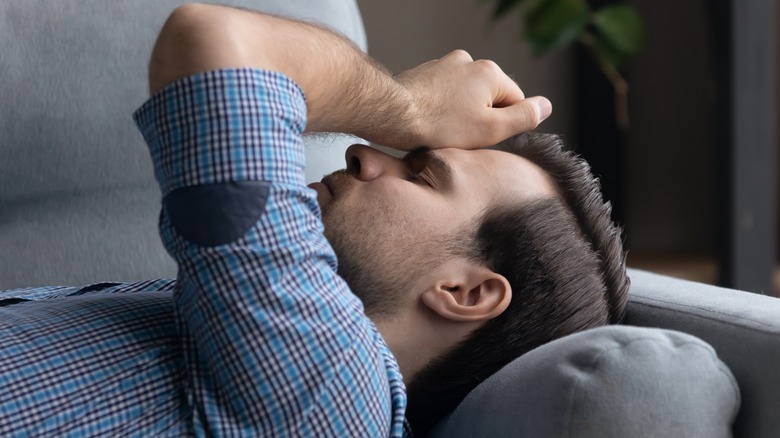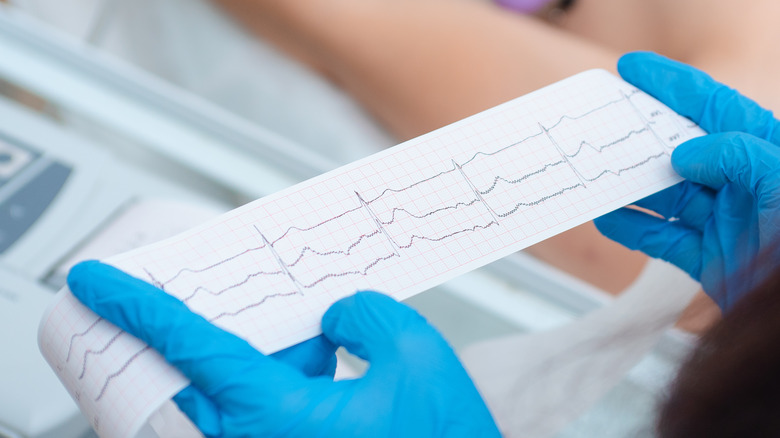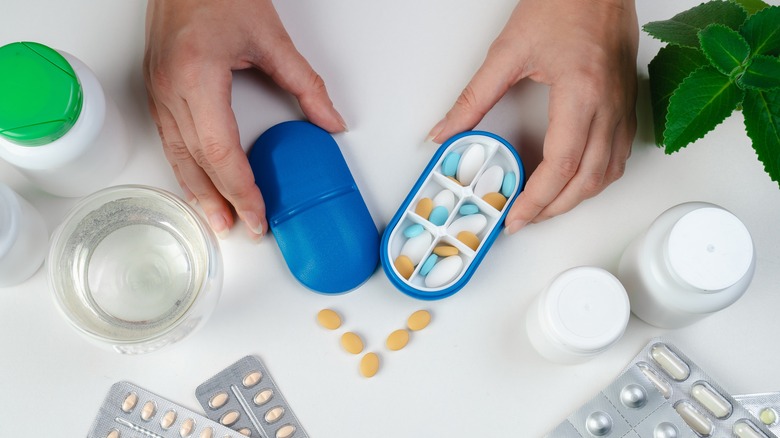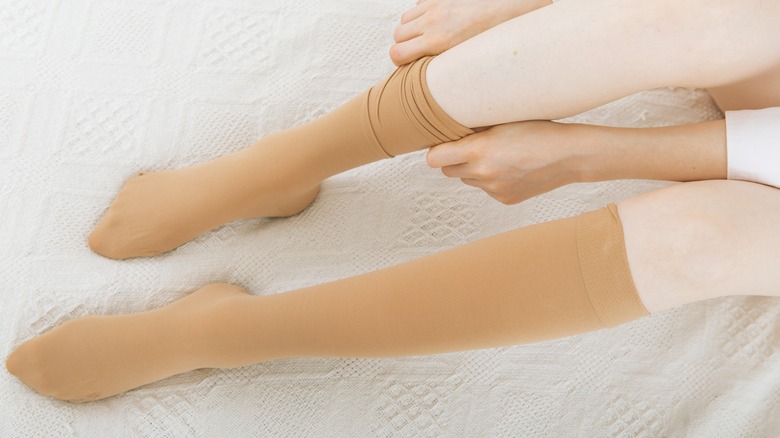Your Guide To POTS & The Massive Effects It Can Have On Your Life
Postural orthostatic tachycardia syndrome (POTS) is a type of autonomic dysfunction that affects the body's ability to regulate blood pressure and heart rate in response to changes in position (via PoTSUK). More specifically, postural refers to the body's position, orthostatic means it is related to or caused by an upright posture, tachycardia is the medical term for a fast heart rate, and syndrome reflects a group of symptoms that happen together. Having an autonomic dysfunction means that the part of your nervous system that controls basic and involuntary bodily functions (such as breathing, blinking, heart rate, digestion, and body temperature — a.k.a., those that you don't have to think about in order to perform) doesn't work properly (via Healthline).
POTS is not only a chronic disease (meaning that it is long-lasting), but also a rare chronic condition. This means that people often experience a group of symptoms that are difficult to diagnose because they don't match any known or common illnesses or diseases. Dealing with a rare chronic disease can be a challenging and isolating experience. Unlike more common illnesses, there may be limited medical knowledge and resources available for diagnosis and treatment, which leads to patients seeing many different doctors trying to find answers to their health problems, a process that can take several years. Plus, aside from leaving patients feeling helpless and uncertain about their future, the whole process also delays potential treatments (via U.S. News). This article tells you all you need to know about POTS.
What is POTS?
According to a study published in the British Journal of General Practice, POTS is a condition that leads to an increased heart rate upon standing up. When you stand up, gravity causes about 500 milliliters of blood to drop from your chest into your abdomen and legs. Yet, your autonomic nervous system responds by slightly increasing blood pressure and heart rate to compensate and redistribute your blood throughout your body. In people with PoTS, this compensating mechanism doesn't work appropriately, leading to blood remaining in their lower extremities. When this happens, their hearts try to beat faster to compensate even more, leading to PoTS symptoms. Because the issue relies on the ability of the autonomic nervous system to do its job, PoTS is known as a form of dysautonomia (a.k.a, an impaired autonomic nervous system).
Before getting its name in 1993, POTS was known as idiopathic orthostatic intolerance, irritable heart, or soldier's heart. While it can affect anyone, it is more common in women between 15 and 50 years of age. In fact, according to Standing Up to POTS, it is believed to happen to about 1% of teens or roughly 1–3 million people in the U.S. Despite being a long-term condition, research suggests that people who get an early diagnosis and treatment are more likely to gradually experience a reduction in symptoms. Nevertheless, its evolution may vary from one person to another, and in up to 25% of the cases, POTS can interfere with school or work attendance.
Types of POTS
POTS results from a dysfunction in the autonomic nervous system, but its exact cause is still unknown. However, per the National Library of Medicine (NIH), there are five proposed causes or subtypes. Neuropathic POTS is characterized by damaged or injured nerves in the lower limbs. This leads to a widening of the blood vessels, resulting in blood pooling in the abdomen and legs. Meanwhile, hyperadrenergic POTS is believed to affect 30 to 60% of people with POTS, and is known to result from high levels of norepinephrine, a stress hormone. This type is linked to symptoms such as palpitations, tremors, and anxiety.
The third subtype, hypovolemic POTS, affects up to 70% of people. These patients often have abnormally low blood, plasma, and red blood cell volumes (hypovolemia). This means the heart needs to make an additional effort to pump blood; in some cases, there might not be enough blood to reach all the organs, which can be life-threatening (per the Cleveland Clinic). Per the NIH, the fourth subtype is based on an autoimmune hypothesis: there are higher autoimmune markets in people with POTS that may lead to the dysfunction of the autonomic nervous system. Lastly, deconditioning is a potential fifth subtype. Prolonged bed rest can cause the heart to become unable to pump blood as it used to.
Aside from these possible causes, Johns Hopkins Medicine adds secondary POTS to the list, explaining that POTS can result from a previous condition that can also impair the nervous system (e.g., some autoimmune disorders, diabetes, Lyme disease).
Signs and symptoms of POTS
The hallmark symptom of POTS is a significant increase in heart rate upon standing. However, POTS can also lead to symptoms in other bodily functions, as explained by PoTSUK. POTS symptoms can be divided into orthostatic (the ones that happen when upright or standing), non-orthostatic, and general symptoms. Aside from the increased heart rate or palpitations, orthostatic symptoms can cause dizziness, lightheadedness, chest pain, breathlessness, shakiness, excessive sweating, and sometimes fainting, a common and potentially dangerous manifestation that can affect up to 60% of people with POTS. These symptoms are characterized by resolving when lying down.
As for non-orthostatic symptoms, these often include gut issues such as diarrhea, constipation, bloating, nausea, vomiting, and abdominal pain, bladder problems (e.g., pain above the pubic bone, incontinence), blurred vision, and trouble circulating blood, which leads to peripheral acrocyanosis (a blue-ish purple discoloration of the hands and feet). Lastly, general POTS-related symptoms include brain fog, exercise intolerance, poor sleep, headaches, and chronic fatigue. Symptoms of POTS can vary from person to person. Some patients may experience only mild symptoms that are easily managed, while others may be severely affected and have difficulty performing daily activities. For example, people with POTS report ditching plans with friends or forgetting work responsibilities due to excessive fatigue or brain fog.
Moreover, the severity of symptoms can be influenced by factors such as hot temperatures, stress or sickness, physical activity, drinking alcohol, dehydration, diets rich in refined carbs, and menstrual cycle.
Risk factors
The exact cause of POTS is not fully understood. However, there are certain risk factors that have been associated with the development of the condition. According to Johns Hopkins Medicine, gender and age seem to be among the most common risk factors, seeing that the condition is far more usual in people assigned women at birth with an onset during their teenage or early reproductive years. In addition, people with a family history of POTS may be at an increased risk of developing it themselves. Moreover, POTS may have a genetic component, as researchers have found a link between POTS and some genetic mutations and disorders.
Furthermore, the National Library of Medicine states that POTS may appear after a number of health events, which may include surgery, trauma, pregnancy, and viral infections, such as COVID-19. Per Johns Hopkins Medicine, given the similarity between their symptoms, some people diagnosed with long COVID for having brain fog, heart palpitations, and extreme fatigue could potentially have post-COVID POTS. As Standing Up to POTS explains, the effects of COVID-19 can dysregulate systems in your body that regulate blood pressure and volume. Plus, the persistent inflammatory processes during a COVID-19 infection can also cause damage to your nervous system. Thus, this combination of factors is what leads to POTS-like symptoms and, potentially, post-COVID POTS.
POTS diagnosis
According to a study in the journal Autonomic Neuroscience, the diagnostic criteria for POTS include showing POTS-related symptoms when in an upright position for a minimum of six months that are relieved by lying down, a continuous heart rate increase by more than 30 beats per minute (bpm) within 10 minutes of standing (or more than 40 bpm for people under 19 years of age), the absence of the expected reduction in blood pressure within three minutes of standing, and dismissing other potential causes of rapid heart rate (e.g., medications, caffeine, panic attacks).
To help tick all the previous boxes, there are several diagnostic tests used to diagnose POTS, which are designed to evaluate the body's autonomic nervous system and cardiovascular function by measuring changes in heart rate and blood pressure when changing positions. Per PoTSUK, common tests include electrocardiography (ECG) and echocardiogram to dismiss other heart problems that may cause POTS-like symptoms; active stand test, which involves heart rate and blood pressure measures while resting and upon standing up; tilt-table test, in which the person is secured to a table that is then tilted to an upright position, which again measures changes in heart rate and blood pressure; 24-hour ambulatory blood pressure and heart rate monitor to track changes during the person's day-to-day life; 24-hour urine collection to check for low sodium and high norepinephrine levels; and blood tests to rule out other conditions that can cause POTS-like symptoms, such as anemia or thyroid disorders.
POTS can be easily misdiagnosed
As with most rare chronic conditions, the diagnostic process for POTS can be complex, expensive, and time-consuming, and aside from requiring multiple tests and evaluations to arrive at a definitive diagnosis, it can be very easy to misdiagnose. According to a study published in the British Journal of General Practice, common factors that make diagnosis challenging include the overlap of symptoms with those of other medical conditions, which often leads healthcare professionals to confuse POTS for panic attacks, anxiety, chronic fatigue syndrome, vasovagal syncope, or inappropriate sinus tachycardia. Moreover, some people may not realize the importance of their symptoms or choose not to share them for fear of being judged, and more often than not, the symptoms are dismissed because the standard practice is to measure blood pressure and heart rate while seated, which shows unaltered results.
To aggravate the situation, people with POTS report having very little support from their healthcare providers, with phrases like "it's all in your head" or "you need a psychologist" being unfortunately common. This is a pressing issue that Refinery29 describes as an example of systemic sexism in medicine, which is evidenced by the reaction women get from their doctors when dealing with hard-to-diagnose chronic conditions such as POTS or endometriosis.
POTS treatment options
The treatment for POTS aims to manage symptoms and improve quality of life. This typically involves a combination of lifestyle modifications and medication, which means that, in most cases, a multidisciplinary approach is needed, according to Standing Up to POTS.
Based on medical consensus and evidence from small studies, healthcare professionals should consider a progressive exercise routine and a potential intravenous infusion of two liters of saline to treat acute POTS decompensations. Similarly, while less established by scientific evidence, doctors may also consider prescribing a daily intake of up to three liters of water, an increased salt consumption, and the use of medicine to treat abnormal heart rhythm.
It is important to note that the treatment plan for POTS should be personalized to fit each person's needs, which may vary depending on the severity of their symptoms and their individual response (via Standing Up to POTS). Nevertheless, a study published in the British Journal of General Practice states that while some people may become bed or wheelchair-bound due to the severity of their symptoms, up to 90% of them respond well to treatment, and about 60% of them have a good chance of being able to function like they did before their symptoms started.
Medications for POTS
According to Standing Up to POTS, there is no known cure for POTS. However, a significant part of its treatment is based on a combination of off-label medications approved by the Food and Drug Administration that help with its symptoms and, ultimately, help improve quality of life. The site divides the medicines into four groups based on their function, starting with those used to treat heart rate problems, followed by blood pressure drugs, those recommended for brain fog and fatigue, and a group of diverse medicines that help with secondary symptoms (e.g., depression, pain, inflammation, allergy-like symptoms).
Common medications for heart rate problems include beta-blockers (such as propranolol or bisoprolol), ivabradine, and verapamil. These drugs are suggested for people with hyperadrenergic POTS and low and high blood pressure, respectively, and can be especially helpful in managing symptoms such as palpitations and tremors. As for those used to treat blood pressure issues, these include drugs such as DDAVP, an antidiuretic that increases blood pressure by reducing urination; midodrine and droxidopa, two vasoconstrictors or medications that narrow blood vessels to increase blood pressure; fludrocortisone, a type of steroid that increases blood volume (this is the most commonly prescribed option); pyridostigmine bromide, a cholinesterase inhibitor that improves blood flow; and clonidine, a medication that relaxes the sympathetic nervous system to reduce blood pressure. Lastly, drugs to treat brain fog and fatigue include stimulants that are also used to treat attention deficit disorder (ADD) and modafinil, which promotes wakefulness.
Exercise is key, but some people with POTS have exercise intolerance
Exercise intolerance describes a condition in which a person experiences an inability or reduced ability to perform physical activity or exercise (via Medical News Today). It often includes symptoms like fatigue, pain, weakness, or fainting during or after exercise. Aside from coinciding with POTS symptoms, they can make exercising virtually impossible.
However, a study in Autonomic Neuroscience explains that physical reconditioning is a key element for POTS treatment, as it can improve functional disabilities. In fact, exercising for at least three months can improve symptoms so much that some people can be considered to be in remission. Endurance training helps manage your heart rate, while resistance training helps pump blood when your muscles contract.
According to the Children's Hospital of Philadelphia guidelines for people with POTS, one essential strategy is to begin exercising in a horizontal or seated position (a.k.a recumbent position) and gradually transition to upright activities to help avoid postures that may trigger symptoms. Recommended endurance exercises include cycling on a recumbent stationary bike, rowing, and swimming. In contrast, safe resistance exercises include seated rows and leg presses, leg curls and extensions, calf raises, chest presses, back extensions, abdominal crunches, and Pilates-based movements. The guidelines strongly advise avoiding taking more than a two-day break from exercising and never skipping warm-up and cool-down sessions. Also, they recommend wearing a heart rate monitor and returning to seated exercises if upright movements lead to POTS symptoms.
Dietary recommendations for people with POTS
Maintaining a healthy and balanced diet is important for managing POTS symptoms, but this can be quite challenging because the condition often leads to gut-related symptoms like diarrhea, nausea, or constipation (via Cleveland Clinic).
Plan and prep your meals ahead of time to ensure you get adequate nutrition, even when symptoms hit out of the blue. This way, you'll be able to increase your intake of nutrient-dense meals instead of relying on take-out or microwave meals. Also, having a food diary can help you identify and eliminate trigger foods. Additionally, following general nutrition guidelines (e.g., eating five servings of fruit and vegetables daily, eating enough protein) is advised.
Moreover, Standing Up to POTS shares that, per the 2021 POTS Expert Consensus Review, people with POTS should aim to drink at least three liters of water daily, as well as 3–10 grams of sodium, which you can get from table salt, electrolyte solutions, or salt tablets. Also, avoid consuming a diet rich in refined carbs or high-sugar foods, such as sweets, baked goods, or packaged snacks, as these foods are known to worsen POTS symptoms. Instead, focus on a diet rich in protein, complex carbs, fiber, and healthy fats. Aside from improving your nutritional status, such a diet can also help slow digestion in people with dumping syndrome, a condition that causes food to pass too fast from your stomach into your intestines. Lastly, ginger, peppermint tea, or lemon wedges can be natural remedies for nausea relief.
You may need to make some lifestyle adjustments
Small adjustments to your daily routine can come a long way when trying to avoid POTS symptoms flare-ups. For example, per Standing Up to POTS, people with POTS may benefit from wearing compression socks or abdominal binders to improve and maintain blood flow. Also, lifting the head of the bed can promote fluid retention during the night. In addition, the site suggests avoiding bending over to reduce dizziness and fainting, as well as standing for long periods of time to minimize the effects of gravity. Instead, the site proposes using a chair or stool to do basic daily activities like showering, brushing your teeth, or doing your hair and makeup.
Furthermore, since POTS can lead to poor sleep, the Cleveland Clinic recommends improving your sleep hygiene by following simple tips, including keeping your caffeine intake to a minimum and avoiding its consumption past noon, filtering out sleep-disturbing blue lights from your electronic devices, creating a personalized bedtime routine to get you ready for bed, and sleeping in a dark and cool bedroom. Lastly, while the Cleveland Clinic recommends avoiding exercising four hours before bed, Standing Up to POTS suggests working out at night to tackle insomnia. Thus, when it comes to exercise and sleep, follow the advice that works best for you.
Stress management is also important
Living with a rare chronic disease like POTS can also take a toll on your mental health, as coping with symptoms, a new diagnosis, or even the uncertainty of a delayed diagnosis can lead to anxiety, depression, and other psychological struggles (via the American Psychological Association (APA)). Thus, it may be helpful to seek out support or stress management techniques that help you deal with these emotional challenges. Per the Cleveland Clinic, some potentially useful stress outlets that can also distract your mind from the condition include restorative and chair yoga, which help release tension while lying or sitting.
In addition, practices such as acupuncture or massage therapy can help stimulate your nerves and promote muscle relaxation and blood flow, respectively, which may also improve your symptoms. However, keep in mind that there is currently no evidence of the potential benefits of these practices for people with POTS. Also, the Cleveland Clinic suggests practicing mindfulness or seeing a cognitive behavioral therapy (CBT) professional to rewire negative thought patterns that may affect your mood, self-esteem, and stress levels. Finally, the APA suggests asking your doctor all the necessary questions so that you are well informed about your condition. Since information is power, by doing so, you will be prepared, and no symptom or difficulty will take you by surprise.
Tips on preventing POTS symptoms
It may not always be possible to prevent POTS symptoms entirely, but some tricks or strategies may help manage them and reduce their frequency and severity. For instance, since there are a couple of factors that are known to worsen POTS symptoms, the goal would be to avoid or minimize them. To do this, the Cleveland Clinic suggests quitting drinking alcohol, which not only dehydrates you, but also promotes the relaxation of your blood vessels, lowering your blood pressure. Moreover, since high temperatures also exacerbate symptoms, the site suggests looking for ways to cool your body down, such as showering in lukewarm water, carrying a personal fan, wearing a cooling vest, or spraying cool water on your face, neck, and chest when in hot environments.
Also, since people with POTS have their blood pressure drop when standing up or during prolonged standing, techniques such as flexing your feet and legs can help keep blood flowing. Similarly, a study published in the journal Autonomic Neuroscience shares other strategies such as squeezing a rubber ball, trying the Dutch leg-crossing maneuver (which consists of crossing your legs while squeezing your thighs and glutes), tiptoeing, and even squatting as useful ways to promote blood flow from your lower to your upper body.














